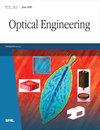基于扩展Rytov理论的大气湍流中零阶贝塞尔-高斯光束闪烁和误码率分析
IF 1.2
4区 工程技术
Q4 OPTICS
引用次数: 0
摘要
自由空间衍射导致接收到的能量在接收器上扩散,从而降低了信噪比。贝塞尔-高斯(BG)光束被认为是物理上可实现的光束,在有限的传播距离上对自由空间衍射具有鲁棒性。非衍射光束已被证明在许多应用中是有用的,例如光学无线通信(OWC)和非线性光学。然而,在湍流中,bg光束确实受到湍流诱导衍射的影响。扩展惠更斯-菲涅耳原理是强湍流作用下的主要分析工具。然而,扩展的Rytov理论(ERT)方法提供了小尺度和大尺度湍流引起的信号波动的表达式,因此特别适合于统计信道建模。在这项工作中,将ERT应用于通过湍流传播的bg光束。导出了诱导轴上小尺度和大尺度对数辐照度方差的封闭表达式。分析了由此产生的闪烁指数。在此基础上,研究了光强调制、m相移键控、偏振移键控和单输入多输出系统下bg波束OWC的误差特性。与高斯光束相比,报告了显着的性能增益。本文章由计算机程序翻译,如有差异,请以英文原文为准。
Scintillation and bit error rate analysis of zero-order Bessel–Gauss beams in atmospheric turbulence based on the extended Rytov theory
Free space diffraction causes the spreading of the received energy at the receiver and thus reduces the signal-to-noise ratio. Bessel–Gauss (BG) beams are considered physically realizable beams, which are robust to free space diffraction over finite propagation distances. Non-diffraction beams have proved useful in many applications, such as optical wireless communications (OWC) and non-linear optics. However, in turbulence BG-beams do suffer from turbulence-induced diffraction. The extended Huygens–Fresnel principle is the main tool of analysis under the effect of strong turbulence. However, the extended Rytov theory (ERT) method provides expressions for the small- and large-scale turbulence-induced signal fluctuations and hence is particularly suitable for statistical channel modeling. In this work, application of the ERT to BG-beams propagating through turbulence is carried out. Closed-form expressions for the induced on-axis small- and large-scale log-irradiance variances are derived. The resultant index of scintillation is analyzed. Then, the error performance of OWC is investigated for BG-beams combined with intensity modulation, M-ary phase shift keying, polarization shift keying, and single-input-multiple-output systems. Significant performance gains are reported compared to Gaussian beams.
求助全文
通过发布文献求助,成功后即可免费获取论文全文。
去求助
来源期刊

Optical Engineering
工程技术-光学
CiteScore
2.70
自引率
7.70%
发文量
393
审稿时长
2.6 months
期刊介绍:
Optical Engineering publishes peer-reviewed papers reporting on research and development in optical science and engineering and the practical applications of known optical science, engineering, and technology.
 求助内容:
求助内容: 应助结果提醒方式:
应助结果提醒方式:


